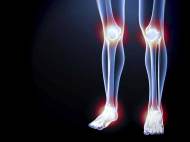A new approach for more efficient cartilage repair and regeneration
 Damage to cartilage may no longer have to be irreversible. A team of EPFL scientists has developed a smart hydrogel material that could promote cartilage regeneration. That would be great news for athletes, elderly, and people with conditions which lead to cartilage degeneration and arthritis. The advantage of this method is its ability to release medication at the right place and at the right time.
Damage to cartilage may no longer have to be irreversible. A team of EPFL scientists has developed a smart hydrogel material that could promote cartilage regeneration. That would be great news for athletes, elderly, and people with conditions which lead to cartilage degeneration and arthritis. The advantage of this method is its ability to release medication at the right place and at the right time.
The cells that produce cartilage in a joint are called chondrocytes. When a joint is at rest, its chondrocytes are mostly inactive, but these cells respond to treatment if they are mechanically stimulated. To exploit this fact, the scientists created a hydrogel that delivers a therapeutic drug to the cells only when they are undergoing repetitive movement.
To be exact, when the same joint is moving, its chondrocytes activate receptors that are sensitive to growth factors produced by the body. The receptors mentioned receptors activate only after 5 to 20 minutes of repetitive movement, since friction generates heat. The method developed by the EPFL scientists Dominique Pioletti and Harm-Anton Klok is based on this concept.
The viscous hydrogel matrix designed by EPFL scientists is designed to deliver the drugs it carries only after a specific number of repeated movements , or when the material reaches a certain threshold temperature. After 5 to 10 minutes of movement, the heat decreases the diameter of the nanoparticles by a third, causing gaps to form in the matrix through which the growth factor can flow out into the target area.
The matrix contains liposomal nanoparticles as well as a therapeutic agent (TGF-beta growth factor), and the mechanism enables fine tuning of the drug release, providing the optimal moment to help the joint regenerate its cartilage.
One way of implementing this approach in the future would involve use of arthroscopy (also called arthroscopic surgery) to implant the matrix at the site of the damaged cartilage. After implantation, targeted physical therapy would be used to mobilize the joint in order to maximize the effect of the medicine.
More work has to be done before the team’s innovative method actually reaches the market. At present, EPFL team has proven the concept from a mechanical standpoint, having successfully delivered a colored dye used in place of the growth factor, but the technique still needs to be fine-tuned.
“Several doctors have shown an interest in our approach, and now we need to find partners and improve the method for in vivo tests”, said Prof Pioletti.
For more information, read the paper published in the journal Biomaterials: “Controlled release from a mechanically-stimulated thermosensitive self-heating composite hydrogel”.










So many news about cartilage repair breakthroughs, yet nothing gets its way into hospitals.
Great way to explain terms by providing more information when you hover them btw!
I find this very interesting and look forward to any future progress this might have. I personally have suffered from cartilage damage and been advised to never again engage in any strenuous ankle activity. This would be great news considering I am only 22 years old and would like to return to strenuous activities sometime in my life.
7/20/14 Again more progress being made. I would like to participate in any clinical trials. I am a nurse. Chronologically, I am considered a senior, I am not retired nor do I plan to be. I just have this problem with worn out cartilage in my left knee. I have been very active all of my life. This challenge is a “glitche” for me which I would like to eliminate if at all possible. Please advise me of any possibilities for participation. Thank you very much. Sincerely, Monica Sahn, RN, MS